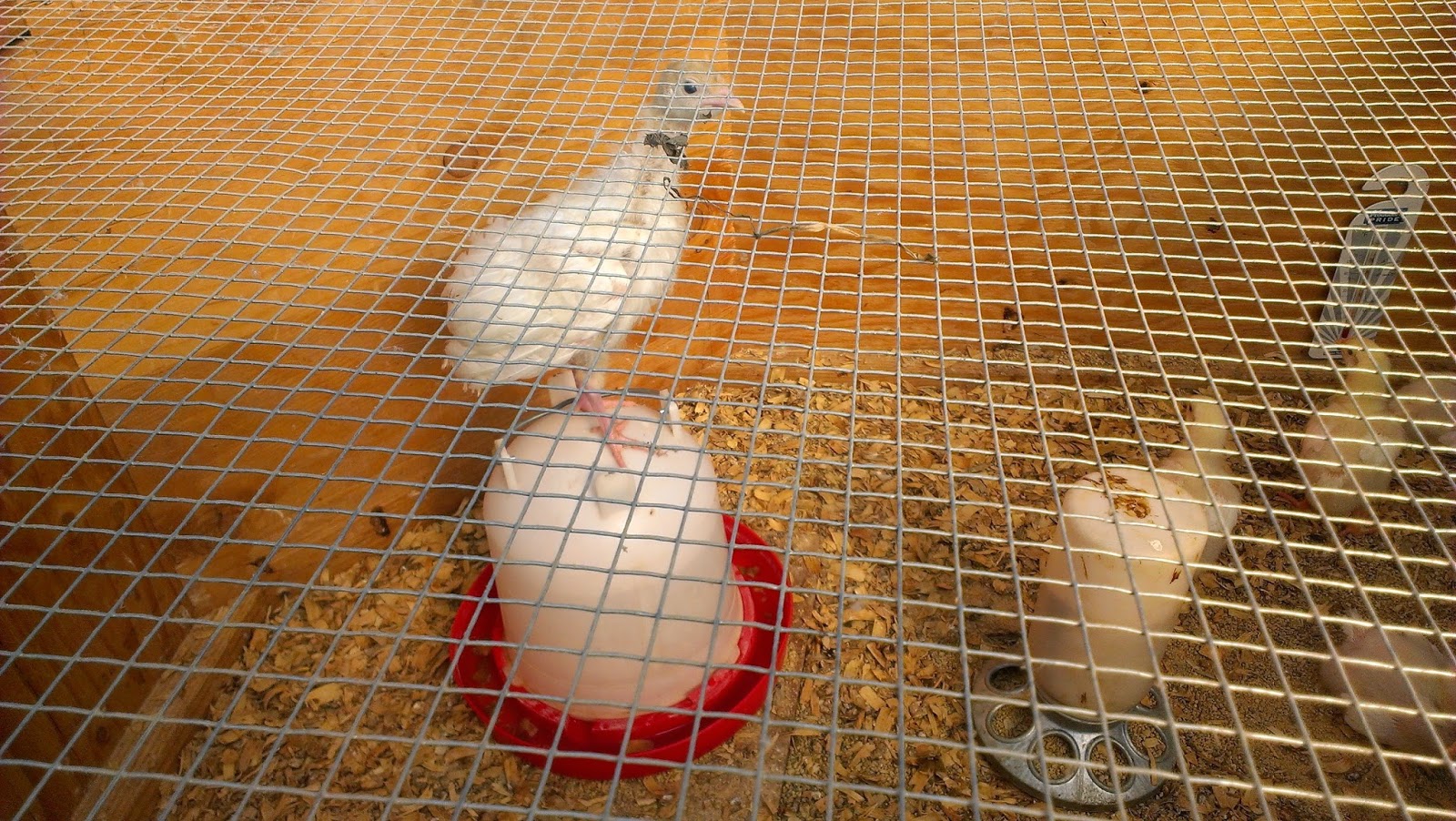So, our mamma had a sizable clutch following her this past February. They were painfully cute.
 |
| You really couldn't get too close without your body erupting in SQUUUEEEEEEE! |
We had some experience with mammas and babies not doing so well in our large open enclosure. Every time we'd go out to feed the birds, it seemed like the mamma hens would have one less baby with them. It could be the ground squirrels (yes, the horrible beasts steal eggs AND babies), it could be crows or other birds of prey, it could even be other chickens or turkey hens. Whatever it is, we were told that the new bird family would do better if we separated them. So, we built them a nice little sub-division. It seemed ok for a few days. Mamma got out- we put her back in. A baby got out, we put it back in. We should have seen it then, but we were perhaps blinded by optimism.
We went out one afternoon to the saddest scene. It seems that mamma got out after we fed them in the morning, and didn't come back. It must've been just a bit too cold, and us just a bit too late, but all 9 babies were lined against the fence, motionless. We piled them up in a box, thanked them for living at our farm, and set out to the compost pile to bury them. I noticed one still kicking. I pulled it up and held its shivering body between my hands hoping to make it comfortable as it left us.
It seemed to take forever, and it just wrenched my heart that it was struggling so hard. I felt for it, but had things to do, so I did what seemed to make sense- tucked it between my boobs to keep it warm and went on with my chores. It soon stopped shivering, and took up kicking instead.
 |
| Pretty sure cleavage was made to support baby birds. |
 |
| Byron was wishing Cleaveland a goodnight. He checked on him every day! He would run out of the car as I got to the farm and run straight to the greenhouse and bark until I opened the door. Cute! |
Cleaveland is doing well, he even escaped yesterday when I was changing out the water in the brooder box. Seems he developed some spunk along the way. Lone chicks rarely do well when introduced to the main flock, so we got him some meat-chicken friends. There are 36 babies running amok in the greenhouse brooder, but Cleaveland is clearly larger, and much braver. He is ready for his big trip out to the big coop with this new friends.
 |
| Atop the waterer, Cleaveland plots his escape. |
The wins and losses of the farm sometimes seem uneventful during all the (controlled) near-chaos that is running a farm. Rarely are they mourned. Losses in earnings are frustrating and stressful. Crop losses can be anywhere from disappointing to devastating. Though, nothing compares really, to when your animals die. You accept that death is a part of life, but it is always sad...The Grace in farming though, comes in second chances. If you can find the heart and courage to try again, that is.
 |
| Two turkey mammas have set up shop out in the back of the poultry enclosure. No one has started to sit yet, but we're hopeful. |
Spring is full of second chances and promises of bounty. Here is a great spring soup recipe from Bon Appetit to whet your appetite in anticipation of those promises. It is a great seasonal transition soup. We're still making use of greens and roots, but herbs make a sneak appearance. It's a cozy winter's-end meal.
INGREDIENTS
- 6 ounces ground chicken (about 3/4 cup)
- 1/2 cup fresh breadcrumbs
- 6 tablespoons finely grated Parmesan, divided, plus more for garnish
- 4 garlic cloves, 2 minced, 2 thinly sliced
- 2 tablespoons chopped fresh chives
- 1 large egg, whisked to blend
- Kosher salt, freshly ground pepper
- 2 tablespoons extra-virgin olive oil
- 1 leek, white and pale-green parts only, sliced into 1/4-inch rounds
- 5 cups low-salt chicken broth
- 3/4 cup ditalini or other small pasta
- 1 cup 1/2-inch rounds peeled carrots
- 1 cup (packed) baby spinach
Add leek to pot and cook, stirring often, until beginning to soften, about 3 minutes. Add 2 thinly sliced garlic cloves; cook for 1 minute. Add broth and 2 cups water; bring to a boil. Stir in pasta and carrots; simmer until pasta is almost al dente, about 8 minutes. Add meatballs; simmer until pasta is al dente, carrots are tender, and meatballs are cooked through, about 3 minutes. Add spinach and remaining 3 Tbsp. Parmesan; stir until spinach is wilted and Parmesan is melted. Season with salt and pepper.
Enjoy!




